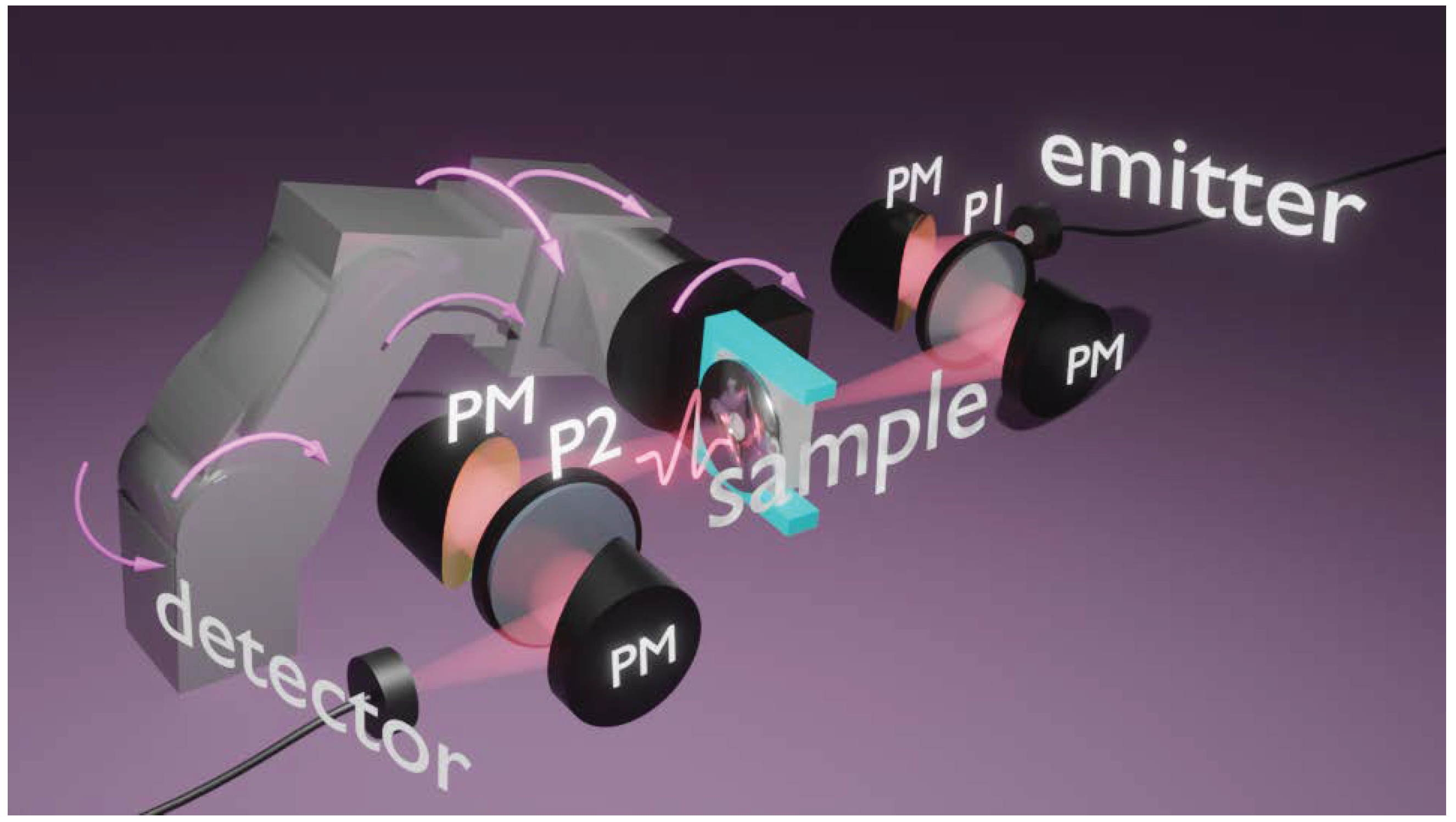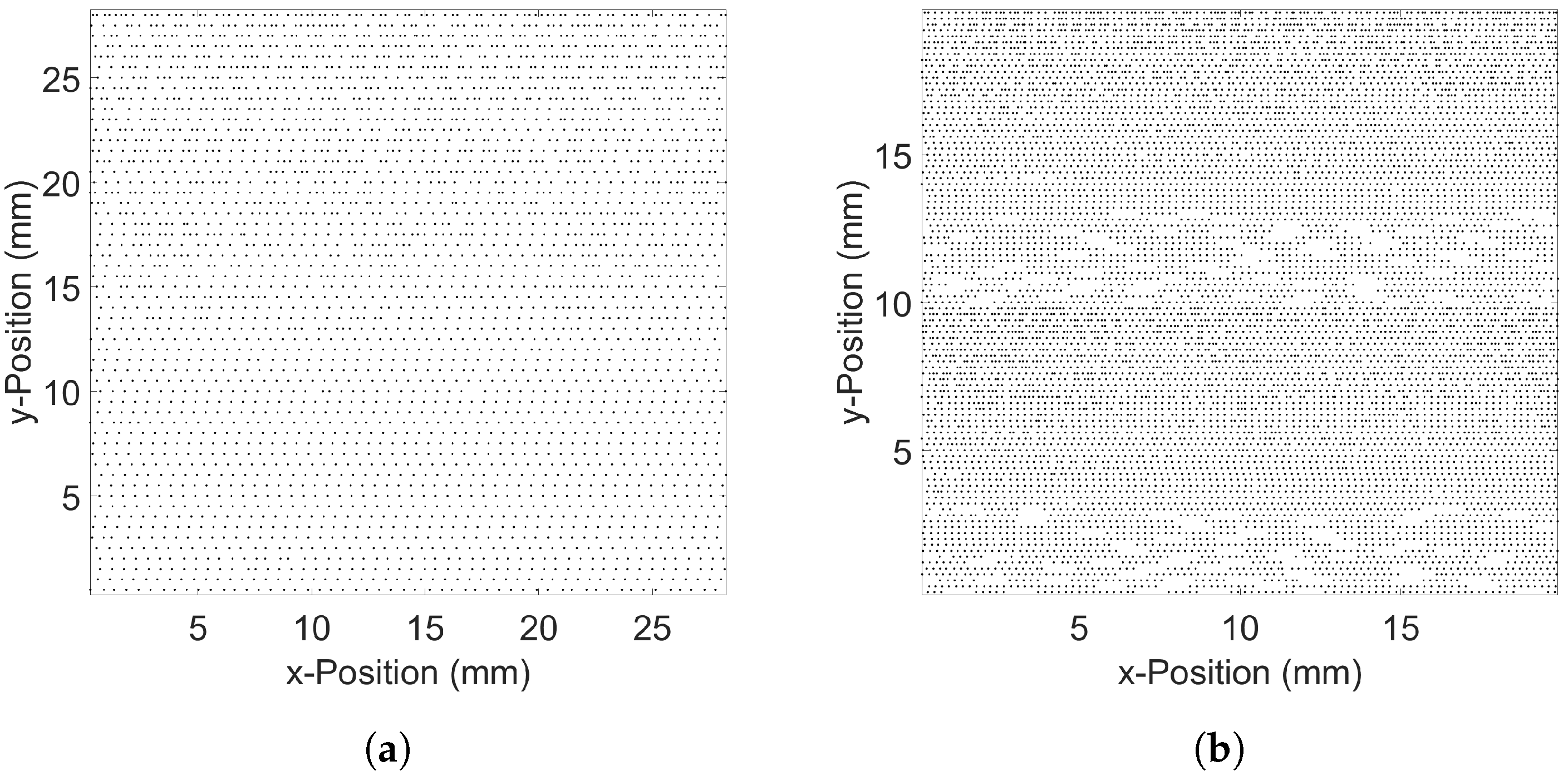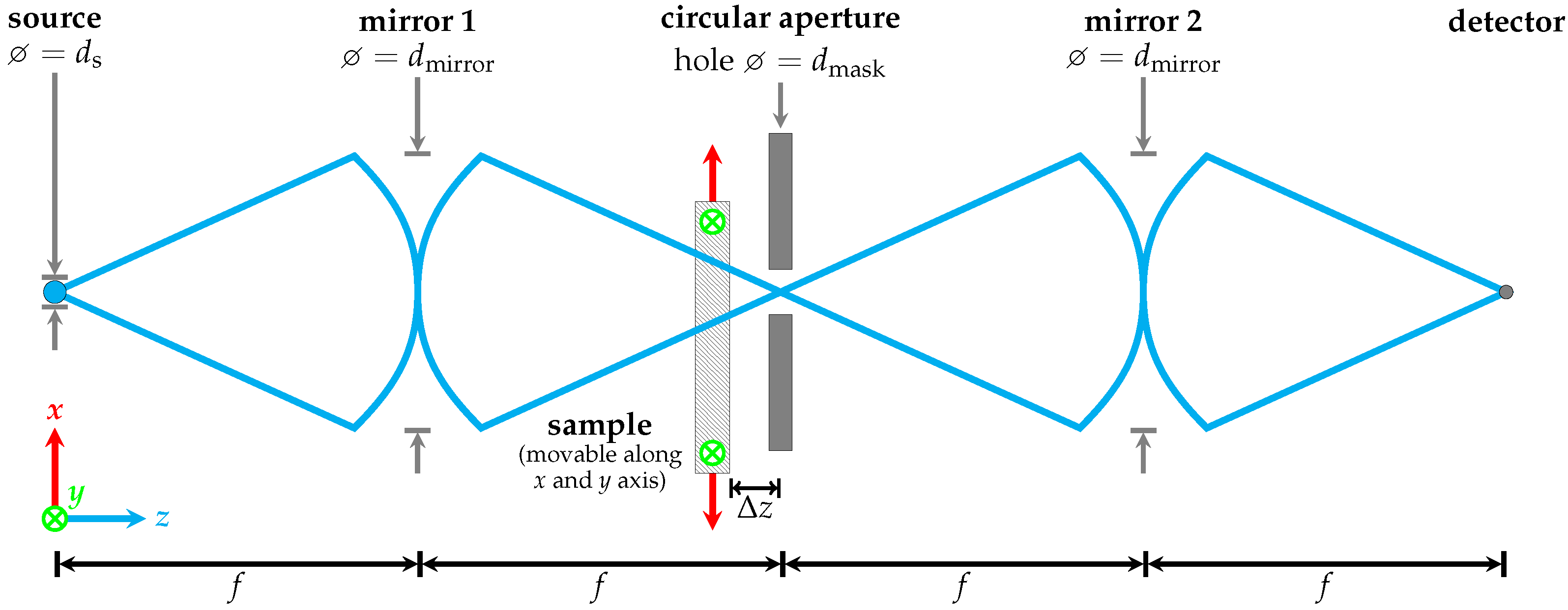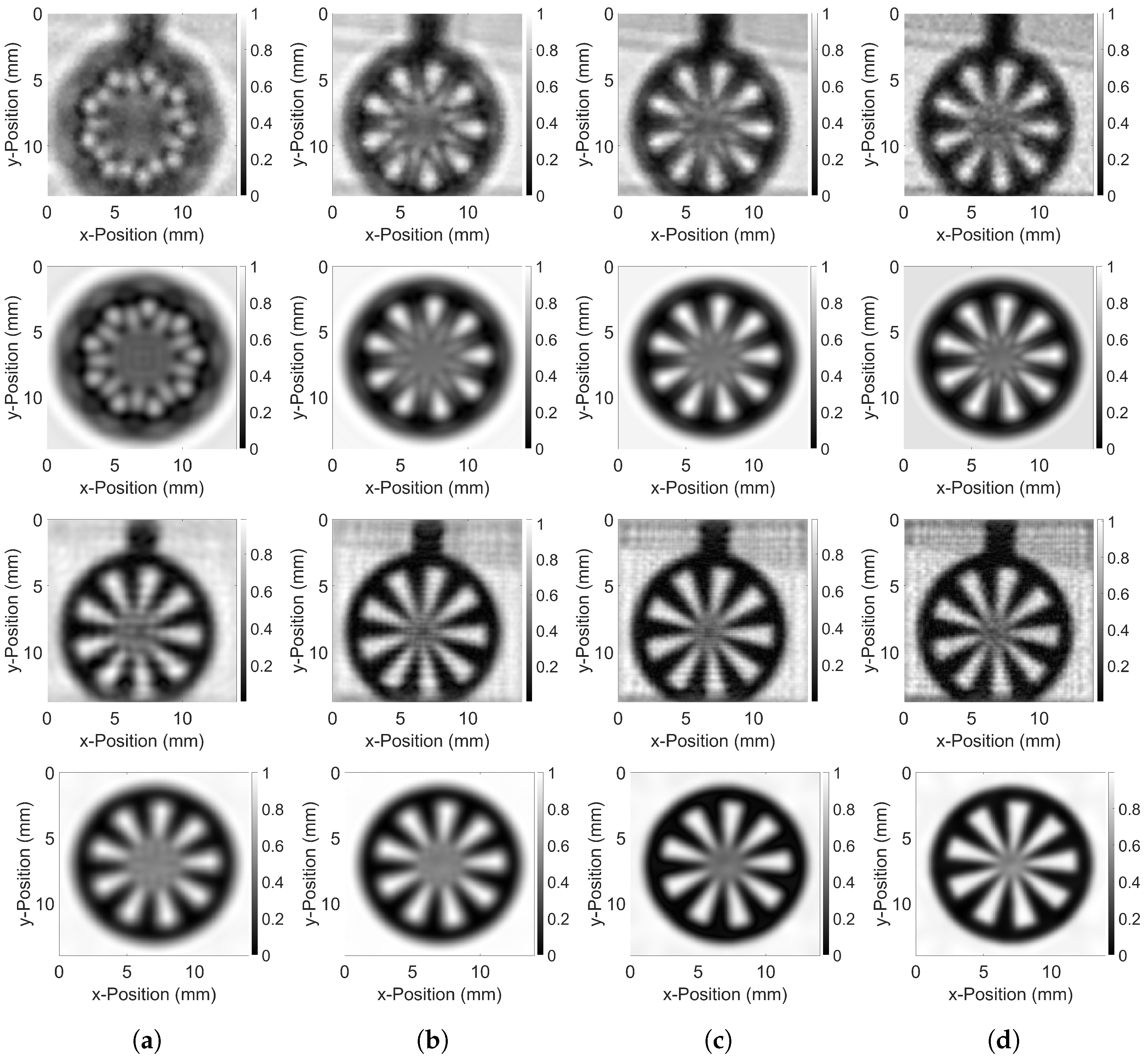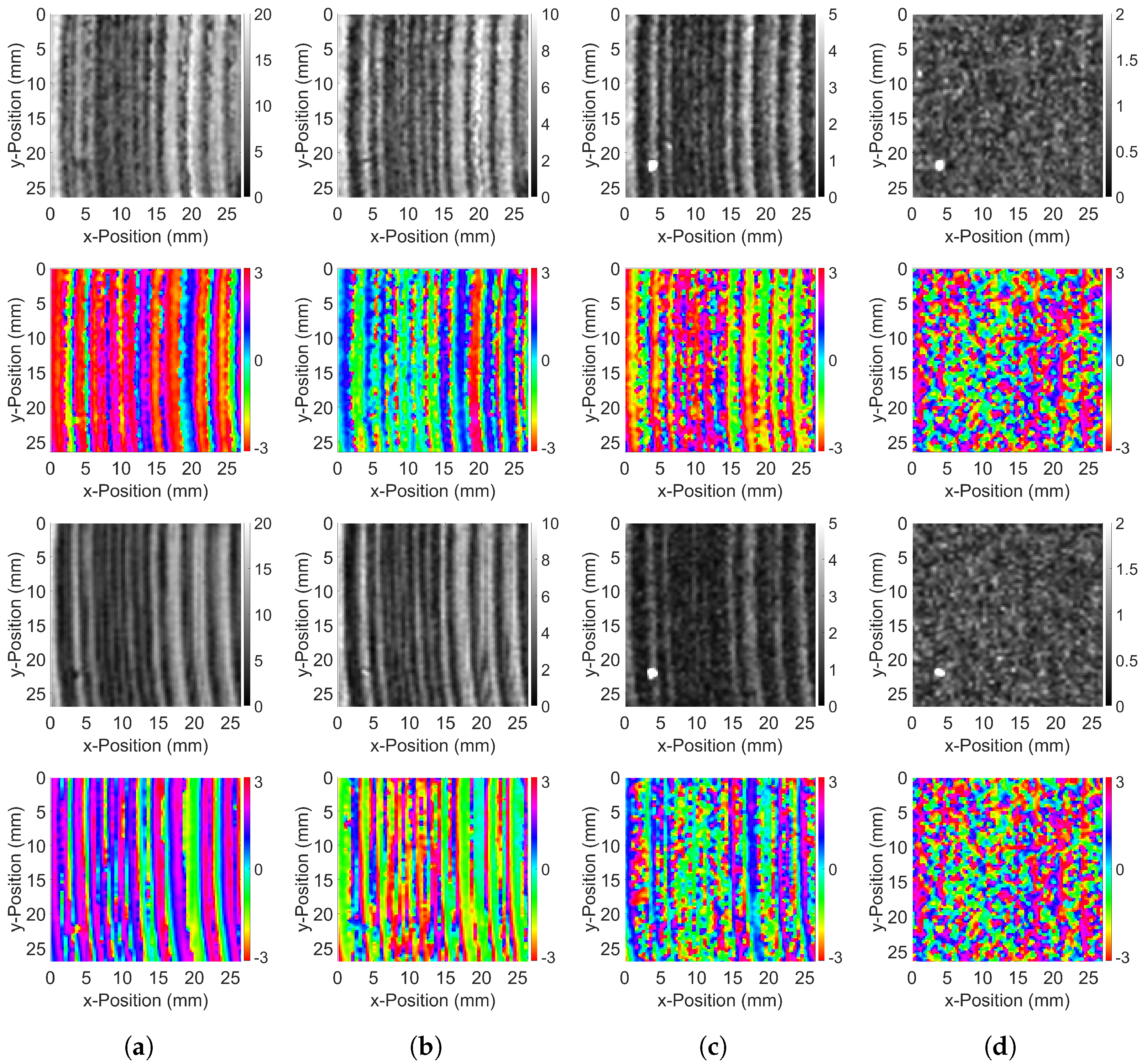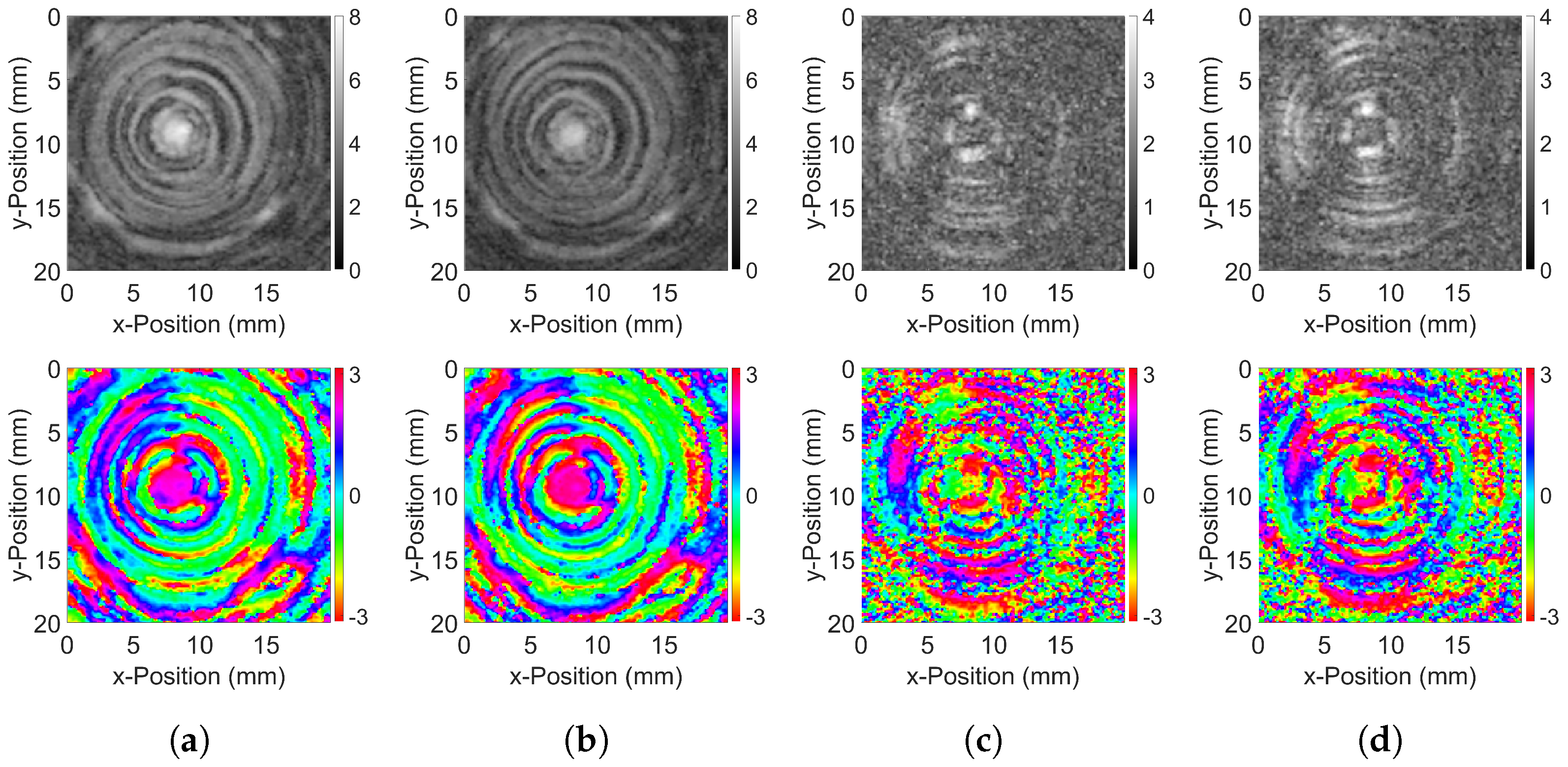1. Introduction
The THz spectral range covering frequencies between 0.1 THz and 10 THz or, alternatively, wavelengths between 0.03 mm and 3 mm is used for sensing applications in non-destructive evaluation, material characterisation, medical and chemical analyses, and security and communication [
1]. THz material properties, such as absorption and thus penetration depth, all depend on the THz wavelength. To obtain a map of THz properties, THz imaging has been developed over the past two decades [
2,
3]. THz imaging using a single wavelength source is evolving towards real-time applications [
4,
5]. To obtain a map of spectral information, THz spectral imaging techniques have been developed and were reviewed recently [
6]. Spectral imaging can be performed using a tunable THz source, but here we focus on THz-Time Domain Spectroscopy (TDS) for obtaining spectral information with a single point detector [
7]. Due to the short THz pulses, they are often used in time-of-flight measurements to determine layered structures, e.g., in the inspection of cultural heritage [
8,
9], while spectral imaging has found applications in the assessment of, e.g., agricultural products [
10]. It is based on scanning the beam using mirrors [
11,
12] or on scanning the object. For measurements in transmission, scanning the object is favorable, typically using an x–y translation stage [
13,
14]. However, such stages might not be ideal, as their travel range and sample mounting possibilities are restricted once a handling system is devised. In contrast, the six axes of a robot arm offer more flexibility, both in travel range and sample handling. Robot-assisted imaging is being developed in medical applications [
15] as well as non-destructive evaluation [
16] and is being explored in THz applications [
17,
18,
19].
The lateral resolution of THz imaging is typically dependent on the beam size of the THz source on the object. To improve the lateral resolution, aperture-based near-field imaging has been reported [
7]. However, reducing the aperture diameter to improve lateral resolution reduces the radiation level on the detector, causing a trade-off between resolution and signal-to-noise ratio. In addition, near-field imaging using apertures is impractical for larger objects, as the object would need to be scanned in close vicinity of the aperture or would need to be lifted off and be approached again for each measurement, which renders the procedure time-consuming. On the other hand, increasing the distance of the object surface from the aperture would jeopardize resolution, as the (sub-wavelength) aperture diffracts the beam to a larger spot. In holographic THz imaging, the lateral resolution is limited by the acceptance angle of the detector array, which is related to the ratio of detector size to object distance [
20]. The phase delay from the measurement point can be retrieved in TDS from the Fourier spectrum [
21]. A THz-TDS image thus contains both the amplitude and phase of the signal, so that a holographic reconstruction [
5] to the object plane can be performed.
In this paper, we present THz-TDS imaging combining a robotic scanning method with continuous signal acquisition and holographic reconstruction of the object to improve the resolution. We apply the method to a metallic Siemens star in order to quantify resolution and to wood samples with birefringent optical properties [
22] to demonstrate the technique on a structured non-metallic object.
2. Materials and Methods
2.1. TDS Experimental Setup
A commercial THz-TDS system TeraFlash (TOPTICA Photonics AG, Graefelfing, Germany) with a bandwidth from 0.2 THz to 6.0 THz was used. The beam from the emitter was focused onto the sample using two off-axis parabolic mirrors shown in
Figure 1 (artistic illustration). For some experiments, a metallic aperture with a diameter of
was placed in the focused beam to restrict the spot size. Two polarizers P1 and P2 (wire grid polarizers G30X10-S from SEMIC RF, Taufkirchen, Germany) allowed setting the polarisation direction before the sample and to analyse the polarisation after the sample, respectively. Raw spectra of the TDS were collected with an in-house extension of the TeraFlash control program written in LabVIEW. The samples were mounted on a robot arm and scanned line by line in a meander-like manner with constant speed (2 mm/s to 5 mm/s) at a specific distance (0.1 mm to 5 mm) from the aperture mask.
2.2. Robotics
In order to allow for 2D scans of the sample, a precise six-axis industrial robot arm (Meca500, Mecademic Robotics, Montreal, QC, Canada) with a positioning repeatability of was used. An electric parallel finger gripper (MEGP-25E, Mecademic Robotics, Canada) was used to control the sample position in the THz beam using a custom-written Python program. Custom gripper fingers were 3D-printed (Material: PolyTerraTM PLA, Polymaker Inc., Shanghai, China; Printer: Prusa i3 MK3S+, Prusa Resarch S.R.O., Prague, Czech Republic) and used to clamp the PTFE-based sample holder with the robot’s end effector. The approach of the sample to the aperture mask was conducted with a manual controlled robot operation in a rectangular coordinate system and visually supervised by the robot operator. Subsequently, the sample was moved horizontally across the mask aperture with a constant velocity. At the end of each line, the position of the robot end effector was recorded along with a timestamp in order to be synchronized with the recorded THz spectra.
2.3. Synchronization
The LabVIEW-based THz-TDS control program stored spectra at a varying rate from 9 spectra per second to 16 spectra per second in an unsynchronized manner. The THz-TDS controller hardware did not allow direct access to the internal timestamps. Consequently, every spectrum was tagged with a software (LabVIEW) based timestamp, which is derived from the computer’s CPU clock and can be assumed to be highly correlated with the effective measuring time. The Python control program of the robot ran on the same computer as the THz-TDS control software and used timestamps derived from the same CPU clock. Due to the hardware abstraction layers and implementation details of the LabVIEW and Python frameworks, offsets may have occurred due to drifting and latencies, which are varying over time. In practice, it was hard to quantify the resulting time scales. A generous, educated guess for the upper error bound is 40 ms, which for the scanning speeds used in this paper results in an error smaller than the expected experimental resolution limit. This allowed the usage of the two timestamps for the synchronization of each measured THz-TDS spectrum with a sample position. However, we still had to consider a small, constant offset originating from the measurement procedure itself, which was determined for a specific scanning speed setting from two consecutive scan lines of the resolution target.
Figure 2 shows a typical mapping of the scan positions of the spectra with the robot movement.
For data collection times above around 7 min, short sequences of spectra are missing and impair reliable data collection. As a solution, the scan was split into several parts, storing the data to disk in chunks. This is illustrated in
Figure 2, where the spectra were collected in two parts, with scanning times of 10 min each. Image data were calculated using a regular grid with a pixel distance of half of the line spacing and attributing the spectrum of the scan position with the shortest Euclidean distance. A
Gaussian kernel with a width of 1 pixel was then applied to the image for smoothing.
2.4. Samples
2.4.1. Resolution Target
As a resolution target, a nine-spoke Siemens star with a diameter of 12 was fabricated from a thick metal sheet using laser ablation. It was attached to a 29 mm × 33 mm × 2.2 mm PTFE holder using tape above and below the star.
2.4.2. Wood Samples
Wood sample #1 (33 mm × 33 mm × 2 mm) is an LR cut from a spruce trunk, showing annual rings of different widths where L is the longitudinal and R is the radial direction. For localization purposes. a 1 mm hole was drilled into the lower left corner of the sample.
Wood sample #2 is a 2.65 mm thick RT cut of a spruce branch where R is the radial and T is the tangential direction. It shows concentric annual rings and a dark core of about 3 mm. Samples are shown in
Figure 3. For both wood samples. the inner part was measured by attaching them to a 33 mm × 33 mm × 2 mm square PTFE holder with a 16 mm × 16 mm × 2 mm opening using double-sided tape.
2.5. Simulation of TDS Experiment
The TDS experiment was simulated using holographic reconstruction. The reconstruction method was based on evaluating the Rayleigh–Sommerfeld diffraction integral by use of the fast Fourier transform. The forward propagation of a complex wave field with wavelength
from a plane at
,
, to a plane at
,
is obtained by [
23,
24].
where
is the two-dimensional Fourier spectrum, and
are the Fourier frequencies for
at
. Back propagation from a given diffraction field to a source field can be obtained by the complex conjugate in Equation (
1).
The simulation of the TDS experiment was conducted by propagating the THz field in steps from the source to the detector as illustrated in
Figure 4.
Starting with a point source or a source with a Gaussian intensity distribution of width , the field is propagated to a parabolic mirror of diameter at distance f corresponding to the focal length of the mirror. The ratio of defines the numerical aperture. The field is then mirrored (by taking the complex conjugate of the field) and propagated by to the sample position. The field is then modified by the transmission function of the sample at position x and y and propagated by to the focal point of the experiment. Here, a metal mask with an aperture of diameter is applied to the field. The field is then propagated by f to a parabolic mirror. The field is mirrored again and propagated to the detector, where the complex intensity is integrated. Parameters of the simulations are the sample position in x and y, the wavelength , , and .
4. Discussion
With the above results, we present a versatile technique for THz spectral imaging. In the following, we will discuss several aspects in view of future use. Two scanning methods were used, either scanning the sample very close to the aperture or scanning at a distance and using holographic reconstruction.
The use of a small aperture close to the sample was key to a decent resolution, including the longer wavelengths. It allows us to overcome the resolution limit given by the wavelength and the small numerical aperture of the setup. Apart from the wavelength, the limiting factors for resolution are mask aperture, sample distance, and sample thickness. Estimated resolutions extracted from the images in
Figure 5,
Figure 6 and
Figure 7 are summarized in
Table 1. They illustrate that, using an aperture mask, the resolution is not governed by the limit given by Equation (
3) but rather by the size of the aperture mask.
The presented simulation of the imaging method is in good agreement with the measurements. It can be used to optimize the setup for a specific imaging task.
The annual ring structure of wood samples is imaged nicely, and the polarisation-dependent images are consistent with a structured birefringent material. The increasing absorption of THz radiation with frequency puts an upper limit of about 2 THz for imaging wood structures. A local mapping of refractive indices and extinction coefficients is not straightforward due to diffraction and interference effects within a sample of a thickness exceeding the wavelength. Here, modelling using multilayer field propagation could give more insights.
The use of holographic reconstruction has the potential for imaging structures embedded in a homogenous matrix or a micro-fluidic device. Furthermore, it allows reconstruction to curved sample surfaces from a planar scan. In order to increase the accuracy of the reconstruction, the illuminated region of the sample could be increased. However, this might negatively impact the intensity passed through the aperture. One may argue that the scanning of a sample close to a mask does not correspond to a holographic data collection. This would only be the case if the sample were illuminated by an infinite plane wave. In this case, scanning a sample before a fixed mask would be equivalent to scanning a mask (representing a pixel of a camera) before a fixed sample. However, the reconstruction works well for a focusing illumination of limited spot size. If holographic reconstruction is used, the spot size on the sample can be optimized in order to allow for proper reconstruction, but still maintaining enough intensity hitting the aperture. A spot size in the order of seems reasonable.
The use of the robot is a new approach compared to traditional XY stages, where only the sample can be scanned. It offers a more flexible way to position the sample. It allows changing the distance to the aperture mask, and the sample can be put in different orientations with respect to the polarization of the incident light. Polarization-dependent measurements can be realized in three ways: (1) by rotating the sample by the robot, (2) dropping and re-picking the sample rotated by 90 (used for wood sample #1), and (3) by setting the polarizer angles manually to (used for wood sample #2). With the robot arm, it is possible to scan a non-planar convex object of known surface shape by minimizing the distance of the sample to the aperture mask and choosing the orientation of the sample with respect to the incident beam. Furthermore, repeatable measurement, e.g., accounting for changing humidity conditions are possible.
The higher jitter in the annual ring structure in the images for
in
Figure 8 indicates that the synchronization of spectrum collection is not perfect and demonstrates one limitation of our scanning setup. This may have led to a slightly lower resolution in the horizontal scanning direction compared to the vertical direction. The extraction of spectra from the available time domain spectrometer control software has its limitation with respect to achievable data rate as well as proper synchronization. However, for the images collected for this work, its influence on resolution is small compared to other factors.
Today’s state-of-the-art TDS systems may offer much faster spectrum collection including in time data storage. Here, it is even more important that the control software allows for low level hardware access or at least hardware clock/timestamp synchronization. In addition, the saving of spectra has to be optimized for reliability at high data rates with low latency.
The rather long scanning times of 6 min to 20 min for our images are due to our specific TDS system and its limited access to the raw spectra. We see a high potential for shorter sample scanning times. With a newer system a speed up to a factor of five seems reasonable, provided that fast data storage is available. Spectrum collection of current TDS systems can exceed 50 spectra per second. Furthermore, an optimization of scanning speed, sample scan area, and aperture size in view of the targeted resolution allows an optimization of scanning times.
